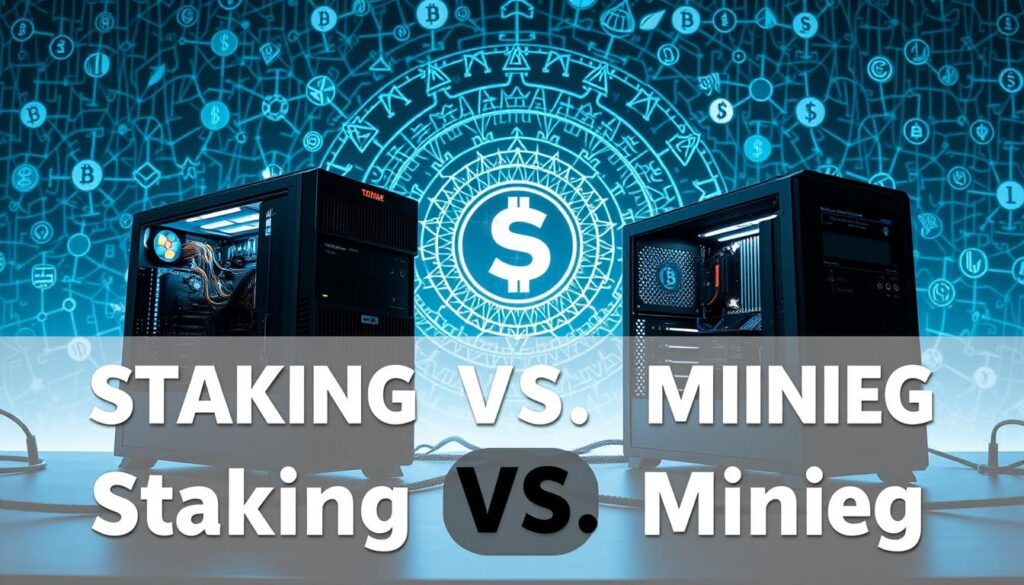Now Reading: The Top Cryptocurrencies to Stake: A Beginner’s Guide
- 01
The Top Cryptocurrencies to Stake: A Beginner’s Guide
The Top Cryptocurrencies to Stake: A Beginner’s Guide

Cryptocurrency staking is a way to make money by holding digital assets. This guide will show you the best cryptocurrencies to stake. It’s perfect for those new to this investment.
Staking means helping blockchain networks and getting rewards. Ethereum, Cardano, and Polkadot are great choices. They are easy to start with and can give good returns. Find out how to begin safely and meet your financial goals.
Key Takeaways
- Staking lets users earn rewards by holding cryptocurrencies.
- Top options like ETH and ADA offer passive income with crypto.
- Risk management and network research are critical for success.
- Staking requires minimal technical knowledge compared to mining.
- This guide covers platforms, security, and strategies for 2023.
Understanding Cryptocurrency Staking: The Basics
Staking crypto means locking digital assets to help blockchain networks and earn rewards. You don’t need special equipment, just a wallet and internet. For beginners, learning how to stake crypto begins with picking the right coin and following platform rules.
Staking offers more than just passive income. It lets you have a say in network decisions, like updates. This is different from traditional investments like stocks or bonds, where you usually don’t get to decide.
What Is Staking in Cryptocurrency?
Staking keeps blockchains safe through a proof-of-stake (PoS) system. Users lock coins to check transactions. They earn network tokens as rewards for helping keep the network secure.
How Staking Differs from Traditional Investments
- No physical assets: Staked coins stay in a wallet.
- Reward variability: Returns depend on network activity, not market speculation.
- Decentralized governance: Holders vote on protocol changes.
The Technology Behind Proof-of-Stake Consensus
PoS systems pick validators based on how much they’ve staked. The more you stake, the better your chances to validate blocks. This method is better for the environment and grows faster than traditional mining.
Learning the basics of staking opens doors to earning in blockchain ecosystems. Researching the best coins and platforms helps make choices that match your goals.
Why Crypto Staking Has Become a Popular Investment Strategy
Crypto staking has become popular because it offers staking benefits that traditional investments don’t. It lets users earn rewards by supporting blockchain networks. These rewards can be higher than what you get from a savings account, making it a profitable staking investment for those looking for steady income.
- Passive income through staking rewards, often yielding 5-20% annually
- Participation in network decisions via voting rights on protocol upgrades
- Lower energy use compared to mining, aligning with eco-conscious investors
Ethereum’s move to proof-of-stake (PoS) in 2022 opened up more opportunities. It made it easier for new investors to join. Now, platforms have user-friendly interfaces that let even small holders participate without needing technical skills. Long-term stakers also benefit from the asset’s price increase as projects grow.
Investors like staking because it offers two benefits: rewards and potential price increases. This fits well with today’s portfolios that aim for diverse income streams. As networks focus on security through decentralized participation, staking is good for both users and the blockchain ecosystem.
Staking vs Mining: Which Crypto Earning Method Is Right for You?
Choosing between staking and mining means looking at energy use, costs, and how long it lasts. This section helps you decide by explaining their differences.

Energy Consumption Comparison
Mining uses a lot of energy. Bitcoin alone uses about 150 terawatt-hours every year. That’s more than many countries use.
Staking, on the other hand, uses almost no energy. Ethereum’s switch to staking cut its energy use by 99.95%. This shows staking is better for the environment.
Entry Barriers and Initial Investment
Getting started is different for each:
- Mining needs expensive ASIC hardware and lots of electricity.
- Staking only needs a computer and a crypto wallet. You can start with as little as $100 on platforms like Coinbase or Ledger.
Staking rewards also don’t face the same price drops as mining hardware.
Long-Term Sustainability Factors
Staking is better for the future:
- Regulations and high energy costs hurt mining.
- Staking fits with ESG goals, attracting big investors.
More networks are moving to staking, like Cardano and Solana. This shows staking is becoming more popular.
Think about your budget, skills, and values. Staking is easier to get into and is more sustainable than mining.
Best Cryptocurrencies to Stake for Beginners in 2023
For newbies, picking the right best cryptocurrencies to stake is key. It’s about finding coins that are easy to use, offer good rewards, and are secure. This guide will show you five top coins that are great for beginners. Before you start, make sure you know the basics of staking to get the most out of it.
Ethereum (ETH) Staking: The Market Leader
Ethereum is a big deal in top staking coins because it’s moving to proof-of-stake. You need at least 32 ETH to start, and you can earn 4-7% a year. If you don’t have enough ETH, you can join a pool to get in.
But, there are risks like network updates and long waits to get your money back.
Cardano (ADA): User-Friendly Staking
Cardano makes staking easy with its delegation system. You can start staking with just a little ADA, and you don’t need to do much. You can earn 5-7% a year, but how much you get depends on the validator.
It’s perfect for those who want something easy to use, even if it’s not the highest return.
Polkadot (DOT): Innovative Nomination System
Polkadot lets you delegate to validators while keeping your DOT. You need at least 100 DOT to start, and you can earn 5-12% a year. But, you’ll need to keep an eye on the technical side and how well validators are doing.
Solana (SOL): High Performance Staking
Solana is fast, which means you can earn 4-8% APY with just 2 SOL. But, you’ll need a special setup and watch out for network problems.
Tezos (XTZ): Pioneer in Liquid Staking
Tezos is a pioneer in liquid staking, which means you can delegate and still use your coins. You can earn 4-6% a year with no minimum stake. But, there are risks like smart contract bugs and validators going offline.
Each option has its own balance of ease and reward. Do your homework on the network and your risk level to find what fits your goals.
Comparing Annual Percentage Yields Across Top Staking Coins
Annual percentage yields (APY) for cryptocurrency staking rewards vary a lot. Investors looking at profitable staking investments need to understand these changes. They also need to know why these differences exist. Right now, we see big differences:
- Ethereum (ETH) offers 4-7% APY, influenced by its ecosystem activity.
- Polkadot (DOT) ranges 8-12%, driven by its nomination system.
- Tezos (XTZ) provides 6-9%, prioritizing stability over high returns.
Higher APYs often mean higher risks. For example, Solana (SOL) might promise 10-15% but faces inflation. This inflation can eat away at your money’s value over time. It’s important to look at real yields, not just the numbers.
Real yields are what you actually get after inflation. For instance, a 15% APY with 10% inflation means you only gain 5%. Always subtract inflation rates when looking at staking rewards.
APYs can change due to many factors like too many validators and updates. New investors should focus on real yields, not just the highest numbers. Finding a balance between returns and project fundamentals is key. Don’t invest in volatile coins without checking their tokenomics and adoption trends.
Security Considerations When Staking Cryptocurrencies
Staking crypto requires careful attention to protect your assets. Before starting with secure staking tokens, it’s important to understand the risks. The Britannica’s crypto staking overview explains that technical issues and human mistakes can harm your investments. This section will guide you on how to strengthen your staking approach.
Evaluating Smart Contract Risks
Smart contracts make staking easier but come with risks. Make sure the protocols are audited by third parties. This reduces the chance of being exploited. Look for projects that are open about their code and have bug bounty programs.
For Ethereum-based smart contracts, use tools like Etherscan. They help ensure the code is correct.
Choosing Custodial vs. Non-Custodial Options
Custodial platforms like Binance or Coinbase make how to stake crypto easy but put your assets at risk. Non-custodial options give you full control but require you to manage your private keys yourself. Key questions include: Who has your private keys? What if the platform gets hacked?
Choose platforms that use cold storage for important funds.
Validator Selection Matters
Choosing the wrong validators can lead to penalties. Check validator uptime using tools like Etherscan or Stake.com. Spread your stakes across several reliable validators to avoid losing everything.
- Always enable two-factor authentication on wallets and exchanges
- Use hardware wallets for long-term staking positions
- Monitor network upgrades to avoid compatibility issues
Essential Hardware and Software Requirements for Effective Staking
To how to stake crypto right, you need the right tools. Whether you’re new or experienced, knowing what hardware and software you need is key. It makes sure your staking is both reliable and secure.
For secure staking tokens on exchanges, you don’t need much. Just a good internet connection and a computer or mobile device. Use two-factor authentication and encrypted wallets like MetaMask or Trust Wallet to keep your funds safe.
For non-custodial staking, you need more. You’ll need a dedicated hardware wallet (like Ledger or Trezor) to keep your private keys safe offline. You’ll also need a desktop with at least 8GB RAM and a stable OS like Linux or Windows 10. Always have antivirus software installed and avoid public Wi-Fi when making transactions.
Validator node operators need even more:
- Hardware: A dedicated server with 16GB+ RAM, SSD storage, and dual power supplies for uptime.
- Software: Node-specific tools like Lighthouse for Ethereum or Docker for Polkadot. Regular OS updates prevent vulnerabilities.
- Network Stability: A static IP address and 99.9% uptime internet plan. Backup generators or uninterruptible power supplies (UPS) safeguard against outages.
Use tools like StakeFlow or blockchain explorers to keep an eye on your performance. Make sure to use encryption protocols and do regular system audits. This way, you can avoid penalties for missing blocks. Finding the right balance between technical specs and security ensures your staking is both reliable and profitable.
Top Staking Platforms and Exchanges for American Investors
Choosing the right staking platform is key to your earnings and safety. American investors need to look for platforms that follow U.S. laws. They should also offer access to the best cryptocurrencies to stake. This staking platform comparison helps you find the best fit for your needs.
Centralized Exchange Staking Options
Big exchanges like Coinbase, Kraken, and Gemini make it easy to start with coins like ETH and SOL. They handle the technical stuff, making it perfect for newbies. Look at fees and what assets they support to find the best cryptocurrencies to stake for you.
Decentralized Staking Protocols
For more control, try Lido Finance and Rocket Pool. They let you join in on blockchain validation directly. These options might give you better returns but you need to keep an eye on the network. Lido’s stETH token lets you keep your funds liquid.
Hardware Wallet Staking Solutions
Security lovers can stake with Ledger or Trezor. These devices work with platforms like Stkr or BlockFi. This way, you get both cold storage and active staking. Make sure your hardware wallet is compatible with your best cryptocurrencies to stake.
Investors looking for a balance might use both centralized exchanges for ease and decentralized protocols for better returns. Always check if the platform follows U.S. laws and understand the unbonding periods before making a choice.
Tax Implications of Crypto Staking Rewards in the United States
Staking cryptocurrency can earn you passive income with crypto. But, in the US, you must report these earnings to the IRS. The IRS sees cryptocurrency staking rewards as income you must report. You need to report the value of these rewards in USD when you get them.

The IRS currently says you should report staking rewards as income when you get them. There’s a debate about whether they should be taxed at the time of receipt or when you sell them. It’s important to keep detailed records of all your transactions.
- Track all staking rewards and their dates
- Document the USD value at the time of receipt
- Use tax software like CoinTracker or Koinly to organize records
There are ways to lower your taxes, like putting rewards in tax-advantaged accounts, like IRAs. It’s wise to talk to experts who know about crypto taxes. The rules are changing, so it’s key to stay updated.
Always talk to tax advisors to make sure you’re following the rules. This info is not tax advice. Always get advice from licensed professionals for your specific situation.
Advanced Strategies for Maximizing Your Staking Returns
Experienced stakers can boost their earnings with advanced tactics. These methods need research but offer better rewards for profitable staking investments. Learn how to make your strategy more effective for growth.
Liquid Staking Derivatives
Derivatives like stETH or bNEO let you use your staked assets without unstaking. You get tokens that represent your staked assets, good for DeFi lending or farming. For instance, Lido’s stETH holders can trade or compound rewards while still earning staking rewards. This way, idle assets become active profitable staking investments.
Yield Optimization Techniques
Maximize gains with these steps:
- Automate reward compounding to reinvest earnings daily or weekly
- Prioritize validators with 99.9% uptime and third-party audits
- Adjust staking allocations during network upgrades to avoid reward halts
These steps make passive income with crypto a steady stream.
Diversification Approaches for Staking Portfolios
Balance risk with a mix of high-yield and stable options. Put 50% in proven networks like Ethereum, 30% in mid-cap projects like Solana, and 20% in new protocols. Check performance every quarter and rebalance to keep growing. Diversification lowers risk from one chain while aiming for the best returns.
How Passive Income with Crypto Staking Fits into a Broader Investment Plan
Passive income from crypto staking can add to your traditional investments like stocks or real estate. Younger investors might put 5-10% of their money into staking to grow their wealth. Those close to retirement might choose 2-5% to manage risk better.
- Compare crypto staking yields to dividend stocks: Staking often offers higher returns but with higher volatility.
- Pair staking with low-volatility assets like bonds to diversify risk.
- Monitor economic cycles: During inflationary periods, staking may outperform fixed-income securities.
Staking benefits are clear for those needing yield without locking funds. It’s different from real estate or REITs, needing no physical work but technical knowledge. In the U.S., staking rewards are taxed as income, unlike long-term stock gains.
- What percentage of my portfolio can tolerate crypto’s price swings?
- Do my long-term goals align with staking’s lock-up periods?
- How does this fit with my overall risk tolerance?
Staking’s role varies based on your financial goals. Start small, watch how it does, and adjust as needed. Always mix crypto staking with traditional investments for stability.
Common Mistakes Beginners Make When Starting Their Staking Journey
Staking rewards depend on careful planning. Avoid these three pitfalls to maximize profits and safety.

Overlooking Unbonding Periods
Unbonding periods lock funds for days or weeks. Ethereum’s 21-day unstaking window traps funds during market drops. Always verify unbonding rules for top staking coins before committing funds. Use a staking platform comparison tool to compare withdrawal timelines across networks.
Ignoring Network Participation Rates
High staking rates reduce individual rewards. When 90% of a coin’s supply is locked, returns shrink. Research participation metrics via platforms like StakingRewards before choosing coins. Low participation may signal low demand, while extremes warn of unsustainable yields.
Chasing Yields Without Understanding Risks
APYs above 20% often hide instability. Terra Luna’s 2022 crash erased $40B in staked funds. Before staking, analyze a project’s roadmap and validator reputation. High returns require deeper research, not impulse decisions.
Preventative Strategies
- Keep 10-15% of funds liquid outside staking positions
- Compare unbonding rules using staking platform comparison sites
- Review validator performance histories on blockchain explorers
Beginners should treat staking like any investment: research trumps shortcuts. Check top staking coins metrics weekly and avoid locking funds without contingency plans.
Taking Your First Steps into the World of Cryptocurrency Staking
Start by making a checklist before you begin. Look into top coins like Ethereum or Solana. Also, check out wallet security options like Ledger or Trust Wallet. Make sure you understand your tax duties with IRS rules.
Learn “how to stake crypto” from official guides. Choose platforms that are easy to use and low-risk. This will help you get started without big risks.
Begin with coins like Cardano (ADA) or Tezos (XTZ) for beginners. Use sites like Kraken or Stakehound for a “staking platform comparison”. Look at fees, APY rates, and how validators perform. Start small to learn about unbonding periods and network participation without big risks.
Join forums like the Ethereum staking subreddit or Cardano’s Discord to ask questions. Keep up with updates from projects like Polkadot’s governance proposals. Remember, staking rewards take months, not days. Be careful not to chase high yields without checking validator reputations or network stability.
Use tools like StakingRewards.com to check your portfolio and adjust strategies. Always update your wallets and watch for security patches. Staking is a long-term game. Focus on learning consistently rather than quick profits. Start small, stay informed, and grow your knowledge and investments over time.
FAQ
What are the best cryptocurrencies to stake for passive income?
Top cryptocurrencies for staking include Ethereum (ETH), Cardano (ADA), and Polkadot (DOT). Solana (SOL) and Tezos (XTZ) are also good choices. Each offers different rewards and risks, fitting various investor needs.
How does staking work and what are the benefits?
Staking means locking up your crypto to help the network. You get rewards for doing so. Benefits include earning passive income, helping govern the network, and possibly higher returns than traditional investments.
What are the differences between staking and mining?
Staking is more energy-efficient and doesn’t need special hardware like mining. Mining solves complex problems to validate transactions. Staking lets users help the network with the coins they hold.
How do I choose a secure staking platform?
Look for a platform with strong security, good user reviews, and follows regulations. Compare centralized exchanges like Coinbase with decentralized options for the best balance of ease and control.
What is the role of validators in the staking process?
Validators are crucial in staking; they check transactions and add new blocks. Picking reliable validators is key. Their work affects your rewards and the network’s security.
Are there risks associated with staking cryptocurrencies?
Yes, staking comes with risks like smart contract flaws and potential fund loss. Also, there’s a risk of not being able to access funds during unbonding periods. Always do your research before investing.
What should I look for in staking rewards?
Look at the annual percentage yield (APY), token inflation, network participation, and past yields. Knowing these helps you choose the most profitable staking options.
How can I optimize my staking returns?
To get the most from staking, diversify your coins, use liquid staking derivatives, and compound rewards. Also, pick validators known for good performance to increase your earnings.














